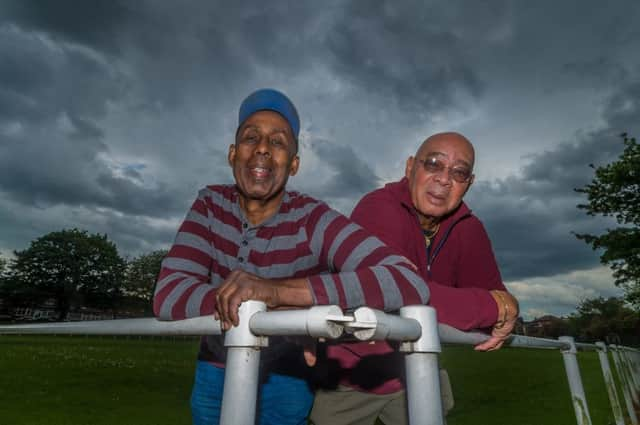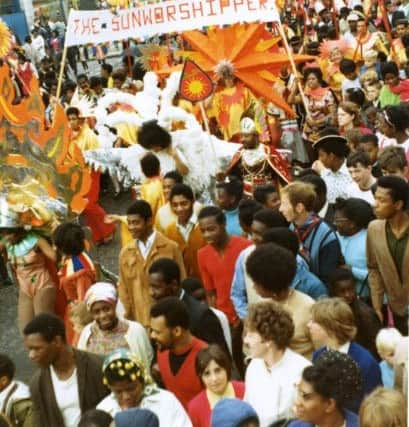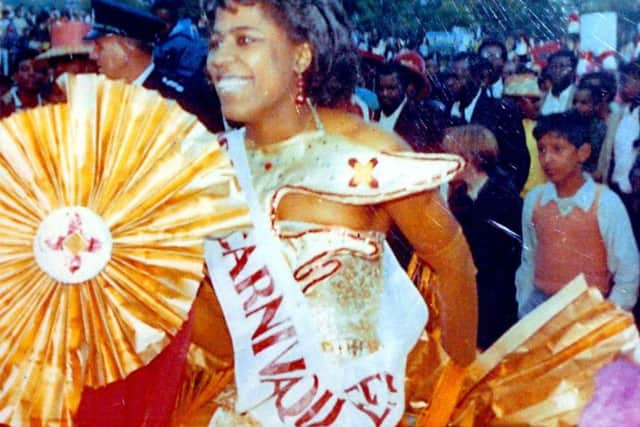Leeds West Indian Carnival - Still inspiring the city's black community after 50 years


As Arthur France looks out at the sea of people gathered in Chapeltown this afternoon, he may just take a moment to soak up the atmosphere and reflect on the phenomenal success of an event that without his hard work and determination wouldn’t exist.
Leeds West Indian Carnival was the first in the country to combine costumes, music and a procession and is also the longest-running Caribbean carnival parade in Europe.
Advertisement
Hide AdAdvertisement
Hide AdMore than 160,000 flocked to last year’s event and with visitors coming from as far afield as Canada, the United States and Trinidad and Tobago to mark the 50th anniversary, today’s crowd could nudge the 200,000 mark.


The carnival has become one of the biggest events on the city’s cultural calendar and is at the forefront of Leeds’ bid to become European Capital of Culture 2023, but when Arthur France and a small band of fellow organisers held the first carnival they could scarcely have dreamt how successful it would become.
Arthur was just a teenager when, like thousands of others from the Caribbean, he left his native Nevis home to make a new life in Leeds in the late 1950s.
As a youngster he was fascinated by the vibrant street carnivals in his homeland and wanted to bring a similar splash of colour to the streets of Leeds.
Advertisement
Hide AdAdvertisement
Hide Ad“When I came to England I felt we needed something to bring us together and the idea was to have a street party where you didn’t need an invitation,” says Arthur, now 80.


He first suggested starting a carnival to the United Caribbean Association, an organisation set up to represent Leeds’s Caribbean population, but the idea was initially rejected.
Undeterred, Arthur persisted and was supported by influential local figures like Willie Robinson and Calvin Beach, who was president of the association at the time, and by 1967 preparations were under way. The date was set for August Bank Holiday Monday, a tradition which has continued through the years.
At the time, the Summer of Love was in full swing with The Beatles’ Sgt Pepper album providing the accompanying soundtrack.
Advertisement
Hide AdAdvertisement
Hide AdBut while metropolitan London might have been swinging, it was a different story in many of the industrial towns and cities across the North of England.


In the Leeds inner-city suburb of Chapeltown, home to most of the city’s growing West Indian population, it wasn’t peace and love that filled the air but racial tension.
In the US, the Civil Rights Movement was at the height of its struggle and in Britain, too, there was social and political upheaval. “Black people were under a lot of stress,” says Calvin Beach. “There was a very charged atmosphere, the racism that was evident at that time was not only affecting the grown-ups it was also affecting the children.”
He says in those days racism was an everyday experience for many black people. “They were feeling it in their jobs and they were seeing it in their schools.”
Advertisement
Hide AdAdvertisement
Hide AdYet it was against this turbulent backdrop that the carnival was born. “We saw the carnival as a pick-me-up for the black population and that’s how it evolved. It was a way of easing some of the emotional pressures that black people were experiencing. But we had no idea at the time just how big it would become.”


Much was riding on the success of that inaugural festival. Arthur bought a dozen chickens to provide enough feathers for the costumes for the five Queens at the Carnival Queen show, which is held a few days before the main event.
The Jubilee Hall in Leeds was packed for the event, and among the judges was the Lord Mayor, which gave the event a real boost. So, too, did having one of the first black television presenters, Clive Alleyne, as compere.
About 10,000 people attended the carnival. The procession wound its way to Leeds Town Hall where a large crowd was entertained by a steel band competition.
Advertisement
Hide AdAdvertisement
Hide AdMerryl Francis, who is now 80, was among those involved. “To be part of the first Caribbean carnival here in Leeds, it was just great. You could see the joy on the people’s faces.”
He’s taken part in every festival since. “It’s brought people closer together and it’s also brought people here from other cities because they think Leeds is the best carnival... There’s no carnival like the Leeds Carnival.”
He says it has helped foster a better relationship between the police and the black community. “People thought we were a bit funny getting dressed up and dancing in the street, but coming from the West Indies we were accustomed to all this. But what amazed me was that after a couple of years you had police officers joining in and dancing in the street in their uniforms.”


Arthur believes the success of the first carnival was crucial. “It was very important because it proved we could organise a festival and it proved a lot of people wrong.”
Advertisement
Hide AdAdvertisement
Hide AdCalvin, 77, agrees and points out that it drew people in from outside Leeds. “Everyone paid for their own costumes and people came to our carnival from places like Huddersfield, Manchester and Birmingham.”
The Leeds troupes were invited to take part in the first Notting Hill Carnival which followed not long after. “In a way we jump-started the carnival in Notting Hill,” he says.
Calvin moved to Canada, where he still lives, in 1978. “The carnival was never a two-man operation it was always a team effort. We had the younger people on our side and that’s why it was a success in those early days.” He believes the reason for its longevity is in no small measure down to Arthur. “It took off in a way we never believed possible.
“Some of us moved away and I don’t think it would have survived for 50 years without Arthur’s input and his love and persistence.”
Advertisement
Hide AdAdvertisement
Hide AdThat’s not to say it’s all been plain sailing. Previously there have been problems coinciding with the carnival. In 1990 a man and a woman were shot dead when trouble flared after the festival, and 11 years later the run-up to the event was overshadowed by a spate of shootings.
However, such trouble is confined to the past and today it’s a colourful jamboree that brings people together from all walks of life. “Leeds Carnival survives because of the goodwill of the community. It’s the people that make the carnival what it is,” says Arthur.
At a time when many carnivals around the country have either petered out or live with the threat of funding cuts, Leeds West Indian Carnival continues to flourish and is viewed by the city council as an important asset.
It has certainly come a long way from the procession that brought a kaleidoscope of colour to Leeds half a century ago.
Advertisement
Hide AdAdvertisement
Hide AdCalvin believes it has created a powerful and positive legacy and given people a platform from which they can display their talents. “You have people who are drawing, people who making costumes, people who now know how to organise a big event and where to seek out funding,” he says.
“The carnival has opened up itself to very artistic black people who without the carnival probably wouldn’t have known they had that talent. It is something that has been created by a black community that still lasts and that hopefully in another 50 years will still be here.”
For details of Leeds Carnival 50 events visit www.leedscarnival.co.uk
Carnival one of the city’s biggest dates
Since its inaugural event 50 years ago, Leeds West Indian Carnival has established itself as one of the biggest dates in the city’s cultural calendar.
Advertisement
Hide AdAdvertisement
Hide AdLast year’s carnival was worth an estimated £5m to the city and over the decades its total contribution to the local economy is put at around £55m.
This year’s carnival is bigger still. There are 21 musical floats taking and 35 troupes.
About 2,000 people are taking part in costumes in the parade including 13 Queens and six King costumes – four times the usual number.
There are two steel bands involved – New World Steel Orchestra from Leeds and Pan Nation from London.